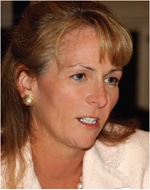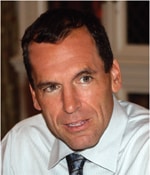PROVIDING CONFIDENCE IN TROUBLED TIMES
As they seek to better understand and manage the risks and value in their portfolios, investors are looking for more support than ever from their custody and investors’ services providers.
Moderated by Joseph Giarraputo
Global Finance: What changes are we seeing in custody and investors’ services customer requirements?
Pat Centanni, executive vice president, global product management, State Street : There is a lot more emphasis on tools that will allow customers to better understand and manage risk and also give them more insight into their operations. Things they perhaps took for granted before, they now want to understand better, and they’re looking at many dimensions of risk, trying to determine their various exposures.
Peter Cherecwich, executive vice president, COO of Corporate & Institutional Services, Northern Trust : Clients are broadening what they’re looking for in the analysis of their exposure. Another change would be liquidity. Historically, clients might have wanted a 30-, 60- or 90-day cash forecast. Now, with the increase of alternative investments, they want to know their entire liquidity situation, which includes hedge funds investments and potential capital calls on private equity. It’s taking what we used to do and adding a whole new dimension now because the answer is so much more critical for our clients.
 |
|
|
Kerry White, managing director, business strategy and development, BNY Mellon : Client requirements tend to be evolutionary. With every new investment there’s a new report or type of transparency you need to provide along with it. Coming into 2009, there were so many pain points for clients, all at once, and we certainly witnessed a move back to basics, with increased scrutiny around operational procedures and basic services. Liquidity is a tremendous concern for clients, too. Lastly, there is a plethora of regulatory changes that have been impacting them all, be they mutual funds or pension funds or the banks themselves. They’re grappling with that at the same time, so in the past year or 18 months the rate of change they’re dealing with has been a bit more rapid than usual.
GF: How do you keep pace with clients’ changing needs?
White: We’re constantly having to rebalance the priorities. We tend to divide up our capital plan between the basic things they need to keep the lights on—regulatory imperatives, Swift releases that need to be engineered—and the things you’re looking out for on the horizon. Sometimes we’ll have to provide it in more of an ad hoc fashion in year one, and then it’s something that’s more automated in year two and onward.
Cherecwich: Often, there’s no single right answer. If a client asks us for a model that allows us to project what their capital calls will be, it’s not going to be rock solid; it’s a model. It needs to be used as a tool. And there may be other tools that the clients have to look at and then use their own judgment to come up with an answer. Forecasting when a maturity is coming due is rock solid, but we’ve moved beyond that now to where there’s no right answer.
Centanni: We are constantly talking to our customers to ensure that we develop services that are going to satisfy most of their important needs. Customers appreciate this approach because they have a voice in the development process, and it makes them feel more comfortable with the services we offer. And they’re talking to other advisers as well, and so it is by working closely with customers that we begin to draw a common future together.
 |
|
|
Cherecwich: The clients are also more interested in straight-through processing [STP] again. That interest had waned a little bit. They were more interested in what new derivative types you could handle. They still want to know that, but they also are concerned about which managers are sending automated transactions and which aren’t. Things I thought had gone by the wayside are back in vogue. Automation minimizes the operational risk while at the same time potentially their counterparty risks can also shrink.
Centanni: Most of the requests that we get from customers are related to evolving market issues we’ve been trying to address for some time—for example, derivatives. Today, people want to solve all kinds of problems quickly, and they want consistency across their operations. This is essential for a global organization because it simplifies their processes, which makes it easier for them to work with us. They’re also looking for data integration—convergence across more than just the accounting data and holdings and so on, but also in terms of performance, compliance and risk data.
GF: What’s going on in securities lending?
Cherecwich: Clients want as much transparency as possible in terms of all the risks that are involved in a securities lending program.
White: Our clients are very interested in a transparent view of everything that’s going on in a securities lending program. Last year, a lot of things happened at once in terms of liquidity, counterparties and ratings. Our clients now want more transparency, not only about the programs but also on what the actual costs are on the asset servicing side. Clients want us to remain in this business and to be able to reinvest in it, so they recognize it’s important for custodians to figure out an appropriate cost structure.
Centanni: For asset owners, securities financing used to be viewed as a supplement to investment earnings. To the custodians and everyone else it was a small revenue augmentation. Today, it has become a much larger part of the whole model. More clients are getting back into it, and the emphasis is now on transparency, safety and liquidity.
Cherecwich: Demand has waned, but many clients are still interested in it. The form of lending and the remuneration have changed, though, and will be different going forward. Organizations are still creating products and working out how to package the proper risk/reward scenarios to suit different clients. Do they want specials with as conservative as possible collateral reinvestment? Do they only want securities as collateral? There are many different possible combinations, and everyone’s looking at what their client base wants.
GF: How much has demand fallen off?
Centanni: I read a research report that said compared to 2007 the amount of actual available securities industry-wide for loan had dropped almost 50%, and the value of actual securities on loan had dropped about 50%. The numbers are exaggerated, though, because the value of securities in general had declined significantly.
Cherecwich: Which means the collateral you get drops, which means the reinvestment income drops and the spread goes down, so it is the perfect storm.
GF: What sort of concerns are customers voicing around valuations and ratings?
White: There’s been a huge amount of scrutiny around that since last fall. Evaluated prices, particularly for illiquid instruments, are of tremendous interest to fund managers. We have spent a great deal of time in making sure that we’ve got as many sources of pricing as we can, particularly on special or illiquid securities, because our clients are looking for multiple data points. They want to have a very deep view into what makes up the differences between valuations from different sources.
Cherecwich: We have to educate our clients, though, that there is a cost associated with the level of specificity and accuracy they’re demanding. They have to assess how much cost they’re willing to bear to get more and more “accurate.” Two very reputable vendors might come back with different valuations. Which one is right? If you dig into this, you’ll find that actually both could be correct. The whole industry is challenged because what the clients are demanding, in terms of specificity, may not be something that they’re actually willing to pay for.
Centanni: A lot of people blamed ratings agencies for the recent problems, and there is concern that the ratings methodologies are too simplistic. Did the methodologies and the agencies miss key “elements of risk”? The industry is trying to sort that out now. And it doesn’t just apply to securitized products but also for other kinds of investments that are illiquid or less transparent. So, how will the industry get comfortable that the values for many of these securities include the right kind of risk measures and will stand the scrutiny of regulators? Some of these issues may clear up over time as more and more of the regulations that are being discussed are implemented. Everyone will then have a better sense of what needs to be done.
GF: Do you see any appetite on investors’ part to pay for the ratings if they, say, get to pick the agency or the rater?
Cherecwich: In terms of core data, I have not seen many organizations willing to pay.
Centanni: Customers are interested in understanding in more detail how the valuation was calculated rather than simply taking it on face value. In some cases they may be willing to pay more for a valuation where they can understand how it was calculated. The issue is price.
White: We all pay for reference data, and our clients recognize that it’s an important part of our business. That’s not to say they don’t have an appetite for something better, but nobody has created that better mouse trap just yet.
Centanni: It’s unfair to blame the ratings agencies entirely. Part of the issue is that people just didn’t connect the macro situation with the ratings. You not only have to go by what the metrics tell you, but you have to incorporate macro trends.
GF: Do clients have an appetite for alternative investments at present—and what kind of questions are they asking you about them?
Cherecwich: Many people were predicting earlier this year that pension plans would get out of hedge funds and institutions would scale back on derivatives use, but I haven’t seen that come to fruition. We’ve seen the growth rate in those types of investments slow down dramatically, but they’re here—and they’re here to stay.
White: We’ve certainly witnessed over the past 15 years or more an increasing appetite. It has waned a tiny bit as people have tried to rein in some of their committed exposure. Many of our clients, particularly the large foundations and endowments that have sometimes north of 50% of their assets in alternatives, are trying to balance their need for cash flow. A number of them have worked with some of their alternative investment managers to maybe dispose of some of their positions. On the flip side we’ve had smaller clients with a relatively small exposure to alternatives be willing buyers.
Centanni: Alternative investment managers are under a lot of pressure to provide more disclosure. There has been a bit of a pullback in some of those asset classes, but I think in the second quarter of this year you’ll see there have been inflows into hedge funds. Alternative asset classes are beginning to see light. We are seeing more interest in new types of asset classes, such as infrastructure, and discussions about creating other kinds of securitized products. An example is the concept of taking life insurance policies and packaging them into a new asset class.
White: A number of our clients are looking at that, particularly those that are out on the frontier. They’ve been allocated to alternatives for quite some time, and so they’re interested in that as the next emerging kind of packaged product.
Cherecwich: In terms of transparency, those organizations that have enough investment dollars—say $50 million or more per account—have been reasonably successful asking for managed accounts, similar to where a traditional long manager provides separate accounts for an institution. Fundamentally, it allows the underlying assets to be exposed to the beneficiary so you get much, much more transparency. There is a higher cost, but organizations appear willing to bear that higher cost in order to get the transparency they’re looking for.
Centanni: The fastest-selling product this year has been custody. Investors want to know their assets are segregated and being well taken care of. As investment managers move away from some of the prime broker models, there is more of an emphasis on segregation, safety and liquidity.
White: We’ve witnessed the same sort of change, and it is very much around safety. It’s not necessarily taking certain functions away from the prime broker but taking the custody specifically away and saying I want this to be held at a custodian that I feel is reputable.
GF: Is that a Madoff effect?
Cherecwich: It really started right after the Lehman collapse.
White: A hot topic with our clients is due diligence. Clients with a large portfolio of alternative assets exercised a great deal of due diligence when they were initially investing into one of these funds, but after five or 10 years they want to take a closer look again. Many have entered into programs to take a very specific look at the operational due diligence of these funds in particular and what’s going on in the back office.
Centanni: There is a lot more emphasis on collateralization. Collateral is becoming more and more important in our business.
GF: In terms of regulation, what changes have you seen or do you expect?
Centanni: It’s like looking up in the summer sky and seeing the clouds rolling in. Will there be a big thunderstorm, or is it just going to be modest rain? The change is coming from two directions. The regulators themselves—not just in the United States but globally—are looking at how they want to regulate different financial entities. The second element is the legislators. They are also looking at creating new laws, some of which are directed at the market participants and some at the agencies that do the regulation. Both sides are grinding through the process. It is a matter of extent. It will be interesting to see if there is a desire to harmonize regulation globally—while also safeguarding domestic institutions. Everyone wants more consistency and accountability for the whole global industry.
White: In addition to those looming clouds that are on the horizon, clients are already dealing with a lot of new requirements that have come into play in the past 12 months. More will be coming in the next 12 months. Some of these have already been outlined, but there are still a lot of gray areas when regulatory changes come into play. It will be an active period for the next few years, and we’ll all be trying to figure out the best way to meet our clients’ needs through that.
Cherecwich: The most interesting aspect of these changes is what’s going to happen on the global stage with regulation. For example, will Cayman be a domicile in the future that even exists for the funds business, or will it go away or change dramatically? Something has to change: Either they have to change the way they do business and open up, or they’re not going to be in existence. One of the benefits of an offshore fund is that you can have one fund that you could distribute in two, three, four countries without having to register a local fund. Now, if Europe, for example under UCITS IV, comes together, and suddenly you can distribute a fund that’s domiciled in Italy, what’s the value of the offshore fund? Also, some countries will only allow offshore funds to be distributed if they approve of the regulatory framework. Whoever wins that will have a very robust fund business in their market.
White: The global stage is definitely where we are going to see some change. There’s such a huge fund industry in the United States that in Europe many people have said, “We need places like Dublin and Luxembourg to be able to keep the cost of distribution down.” If some of the things that Peter referred to come into play, then they may find that it becomes even less attractive and more expensive.
Centanni: The other side of regulation is that it creates opportunities—in this case, distribution opportunities, depending on what happens with offshore funds and how the regulation becomes harmonized in Asia, for example. It becomes an opportunity to provide our clients in each country with new services, and new types of reporting and tools that will help them manage their compliance requirements.
GF: What changes relating to derivatives will we see in the near future?
Cherecwich: I think we’ll see more regulation and mandated central clearing for certain types of derivatives. That will bring new product ideas and new financial engineering related to risk mitigation. Fundamentally, if you can eliminate that counterparty risk through clearing, there potentially might be some advantages.
Centanni: Credit default swaps have really gotten the attention of the regulators. It appears as many CDSs as possible are going to be cleared, particularly if more of the buy side becomes engaged in the emerging central clearing counterparties [CCC]. If that happens, the industry will feel much more comfortable about credit default swaps. There will be standardization. We will no longer need bilateral agreements with counterparty exposure between the two parties. There will be exposure to the CCC itself. That reduces a lot of operational and credit risk and creates a very different risk profile. As a result, there could be some growth in the market as well as new products and capabilities.
 |
|
|
Security pricing will become less of an issue because there will be an established, posted price. If the migration goes well, we could see interest rate swaps and other kinds of derivatives moving toward the same model.
White: Central clearing certainly would help to allay some of the concerns and fears. Despite all the concern about derivatives, though, our clients’ appetite for them hasn’t diminished. One thing we’ll be watching is what kind of legislation, if any, gets enacted around the pension funds’ ability to buy derivatives specifically to hedge their liabilities.
Cherecwich: One potential development is straight-through processing of derivatives. The large custodians can handle most derivative types on a straight-through basis. However, the overwhelming majority of investment managers cannot electronically submit the information required to have STP, so we’re in a situation where the clients are demanding that we get automated, and we’re ready, but the nature of the actual derivatives makes it very difficult for many investment managers to automate it.
Centanni: When the CCC structures take off, it will create more standardization, which opens the door for more automation.
Cherecwich: We can get there, but it will take a while because the beauty of the OTC contract is it’s individualized for that particular client. In order to get something on an exchange, you’d actually have to have a plethora of options for them to choose from and a significant enough volume.
GF: What issues are most prominent in risk management now?
White: Investors are very much focused on value at risk and on understanding what kind of risks they own in their portfolio. They’re very concerned about their own reputational risk and making sure that they’re doing business with counterparties who are going to be in business. They’re concerned about the safety of their assets, and they want to make sure they have a very transparent set of processes so that their stakeholders know that the people who are making the investment decisions are doing it with the best possible processes and tools at their hands.
Cherecwich: Clients are acknowledging that they really need risk specialists, not only at the custodians but people in-house who understand risk as we do and can take that information and make decisions. It’s hard for organizations because they’re under cost pressures themselves—they’ve had to slim down—so on the one hand our clients are being told to save money, do it with less staff, and on the other hand they’re being told to get much more sophisticated in their analysis.
 |
|
|
Centanni: A lot of what we’ve talked about—customer requirements, ratings, alternatives, asset regulations, derivatives, transparency, reporting—they all come back to risk. As an industry, we’re getting much more concerned about risk, but we’re also getting a lot smarter and more nuanced about what it means. It’s become pervasive in all elements of our business. And to our clients, the asset owners and the asset managers, it all comes down to this question: How does risk affect the assets of their underlying clients and the investment process itself?
GF: Have recent events changed your clients’ attitudes to risk management?
Cherecwich: More sophisticated clients absolutely will not change their commitment to investing. What it will do is make them look more carefully at what the investments are and to look more closely at the risk/reward ratio.
Centanni: The real question is, once we’ve dealt with the current problems, will we then become complacent? I don’t think so; we just become subject to the next potential unforeseen risk that comes along.
White: Risk management is always a hot topic with our clients. Institutional investors recognize that in order to deliver the rates of return that they need, they must accept some element of risk in their portfolios. Investors today are increasingly preoccupied with reputational risk, so we are more frequently engaged in dialogue with our clients about operational risk, systemic risks, counterparty risk, as well as the usual topic of value at risk. Clients are more keenly aware that they need a proper balance between statistical measures to identify risks, and the intestinal fortitude to react once they fully understand what those risks are.
GF: What’s in the immediate future for the global custody industry?
Cherecwich: One of the big questions as the business changes is how custodians earn money. If a client was paying a very small custody fee and then pulls out of securities lending and puts all its cash in a third-party money market fund, it’s pretty hard for a custodian to absorb this change in economics. Clients have to understand that custodians need to be compensated for the services they provide. So everybody’s looking at how we can continue to innovate, and set appropriate fees to ensure the ongoing viability of the industry, which is in the best interest of all.
Centanni: I’m excited by all of the change that is happening because it gives us a very broad stage to create capabilities to help our clients. There are expectations for us to do certain things, to address risk, etc., but it does take investment to do these things, so there needs to be a reasonable balance, a compromise of sorts.
White: I would agree that one of the most imminent changes in the global custody industry is the compensation model. An over-reliance on securities financing to subsidize other expenses is just not appropriate in this day and age. It doesn’t lend itself to the transparency requirements that exist today, or are being considered in Washington for the near future. We are in the next phase of the life cycle of the industry, and it has already changed tremendously in the past 20 years. Clients will continue to look to a global custodian as a trusted partner and will rely upon us to work with them to manage through the slew of regulatory and legislative changes that are on the horizon.



